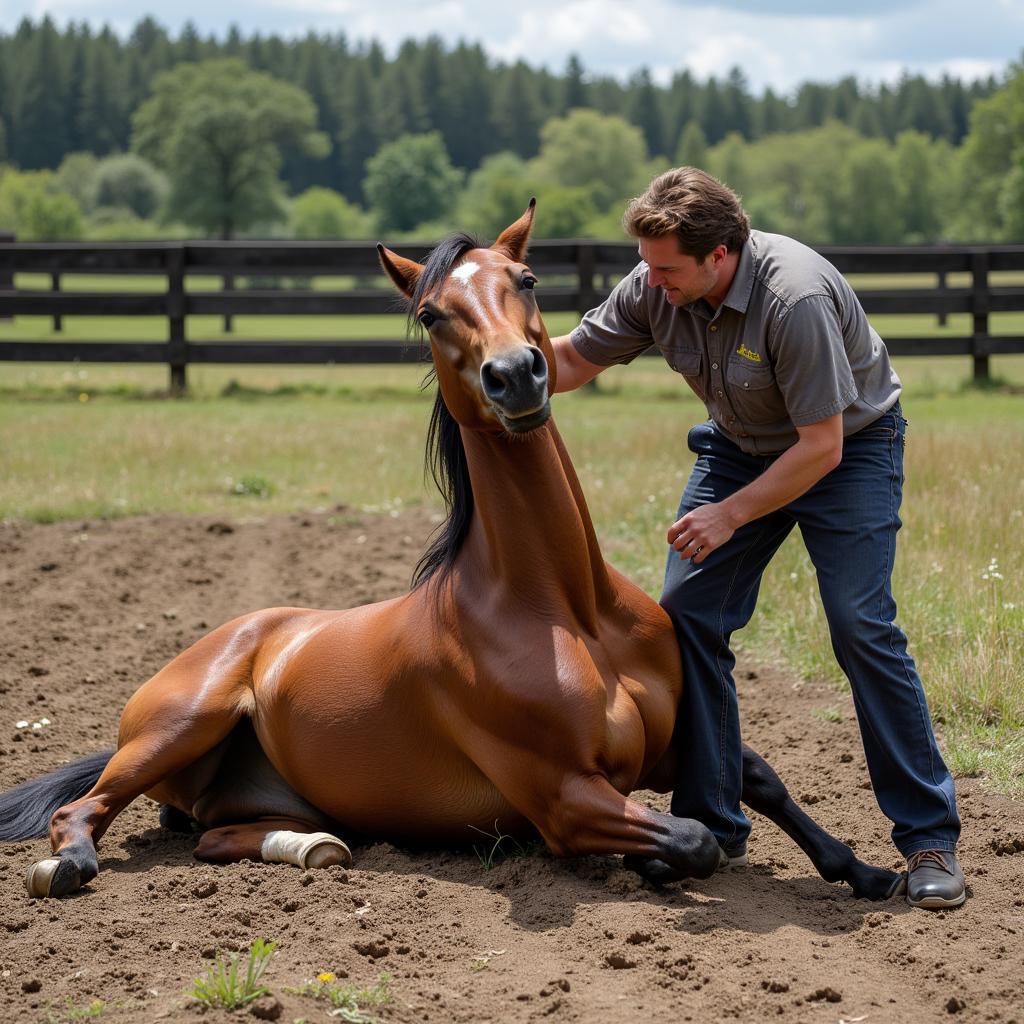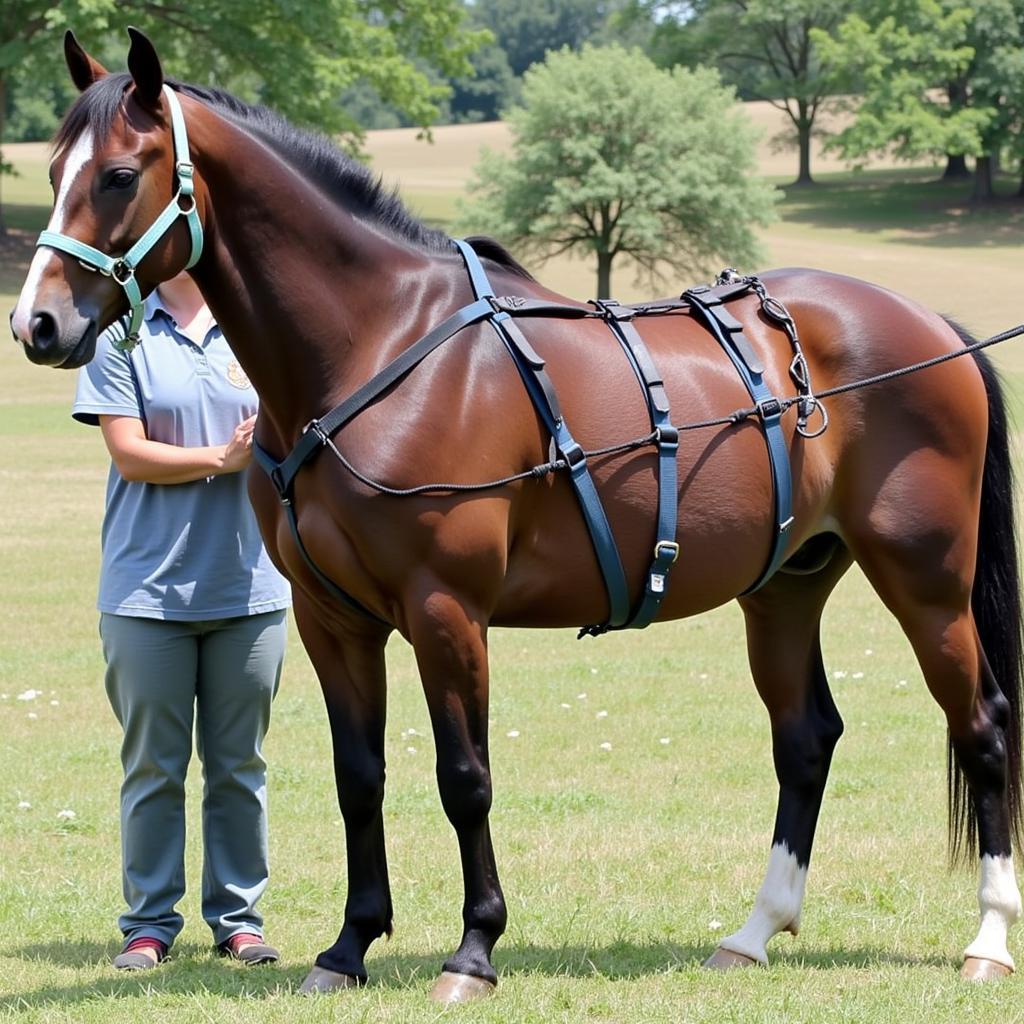A Flattened Horse, sometimes referred to as a “downed horse,” describes a horse that is lying down and unable to get up. This can be a very serious situation, often indicating a medical emergency. While horses lie down to rest, a flattened horse will struggle to rise, even with assistance. This article will delve into the causes, symptoms, and treatment options for a flattened horse.
 A horse lying flat on the ground, unable to stand, with a worried owner nearby
A horse lying flat on the ground, unable to stand, with a worried owner nearby
Causes of a Flattened Horse
The reasons a horse might become flattened are numerous, ranging from simple exhaustion to severe medical conditions. Here are some common culprits:
- Trauma: Injuries like broken bones, deep lacerations, or muscle tears can render a horse unable to stand.
- Colic: Severe abdominal pain from colic can weaken a horse, making it difficult to rise.
- Neurological Disorders: Conditions affecting the nervous system, such as Equine Protozoal Myeloencephalitis (EPM) or West Nile Virus, can cause paralysis or weakness.
- Metabolic Issues: Electrolyte imbalances, often due to dehydration or illness, can lead to muscle weakness and collapse.
- Exhaustion/Debilitation: Prolonged exertion, especially in hot weather, can leave a horse too weak to stand. This is particularly true for horses in poor body condition.
- Obesity: Obese horses are at a higher risk of becoming flattened, as their weight puts added strain on their muscles and joints.
Recognizing the Symptoms
It’s crucial to act quickly if you suspect your horse is flattened. Look for these signs:
- Inability to Stand: The most obvious symptom, the horse remains down despite repeated attempts to rise.
- Distress and Anxiety: The horse might thrash, sweat profusely, or vocalize due to pain and fear.
- Rapid Breathing and Heart Rate: Elevated vital signs indicate stress and potential shock.
- Muscle Tremors: Twitching or trembling muscles can signal weakness, pain, or neurological issues.
Treatment and First Aid for a Flattened Horse
A flattened horse requires immediate veterinary attention. While waiting for the vet, follow these steps:
- Ensure Safety: Keep yourself and others safe from potential kicks or thrashing.
- Provide Comfort: If possible, make the horse comfortable by providing padding under its head and neck.
- Offer Water: If the horse is conscious and able to swallow, offer small amounts of water.
- Keep the Horse Calm: Speak soothingly and minimize noise and distractions.
Do not attempt to force the horse to stand. This can worsen injuries and cause further distress.
 A horse, fitted with a sling, standing in a stable under the supervision of a veterinarian.
A horse, fitted with a sling, standing in a stable under the supervision of a veterinarian.
Veterinary Intervention
Upon arrival, your veterinarian will assess the situation and begin treatment, which may include:
- Pain Relief: Administering pain medication to manage discomfort and reduce stress.
- Fluid Therapy: Intravenous fluids to address dehydration and electrolyte imbalances.
- Diagnostic Tests: Blood work, radiographs, or ultrasounds to determine the underlying cause.
- Sling Support: Using a sling to help support the horse’s weight and encourage standing.
- Specific Treatments: Addressing the underlying cause, such as antibiotics for infection, surgery for fractures, or medication for neurological conditions.
Prognosis and Long-Term Care
The outcome for a flattened horse is highly dependent on the underlying cause, the severity of the condition, and the horse’s overall health. Early intervention and proper veterinary care significantly improve the chances of recovery.
Following your veterinarian’s recommendations for rehabilitation, such as controlled exercise, physical therapy, and nutritional support, is essential for a successful outcome.
When to Seek Help
Never hesitate to call your veterinarian immediately if your horse is unable to rise. Time is of the essence in these situations. Early intervention can significantly impact your horse’s prognosis and chances of a full recovery.
Frequently Asked Questions
Can a horse die from being down?
Yes, a horse that remains down for an extended period is at high risk of developing complications like muscle damage, pressure sores, and respiratory problems, which can be fatal.
How long can a horse be down before it’s too late?
The longer a horse is down, the poorer the prognosis. Ideally, veterinary attention should be sought within a few hours.
What should I do if my horse goes down in the trailer?
If safe, unload the horse carefully and seek immediate veterinary attention.
Can a horse recover from being flattened?
Recovery depends on the underlying cause and the horse’s overall health. With prompt veterinary care and proper management, many horses can recover.
What are the signs of a neurological problem in a horse?
Signs of neurological issues include stumbling, incoordination, weakness, paralysis, head tilting, and seizures.
Need More Help?
Do you have more questions about caring for your horse? We’re here for you! Contact Justus Horses USA at 0772127271 or [email protected], or visit us at QGM2+WX2, Vị Trung, Vị Thuỷ, Hậu Giang, Việt Nam. Our dedicated team is available 24/7 to assist you with all your equine needs. You can also learn more about drawing a horse head step by step or explore topics like horse petlust on our website.